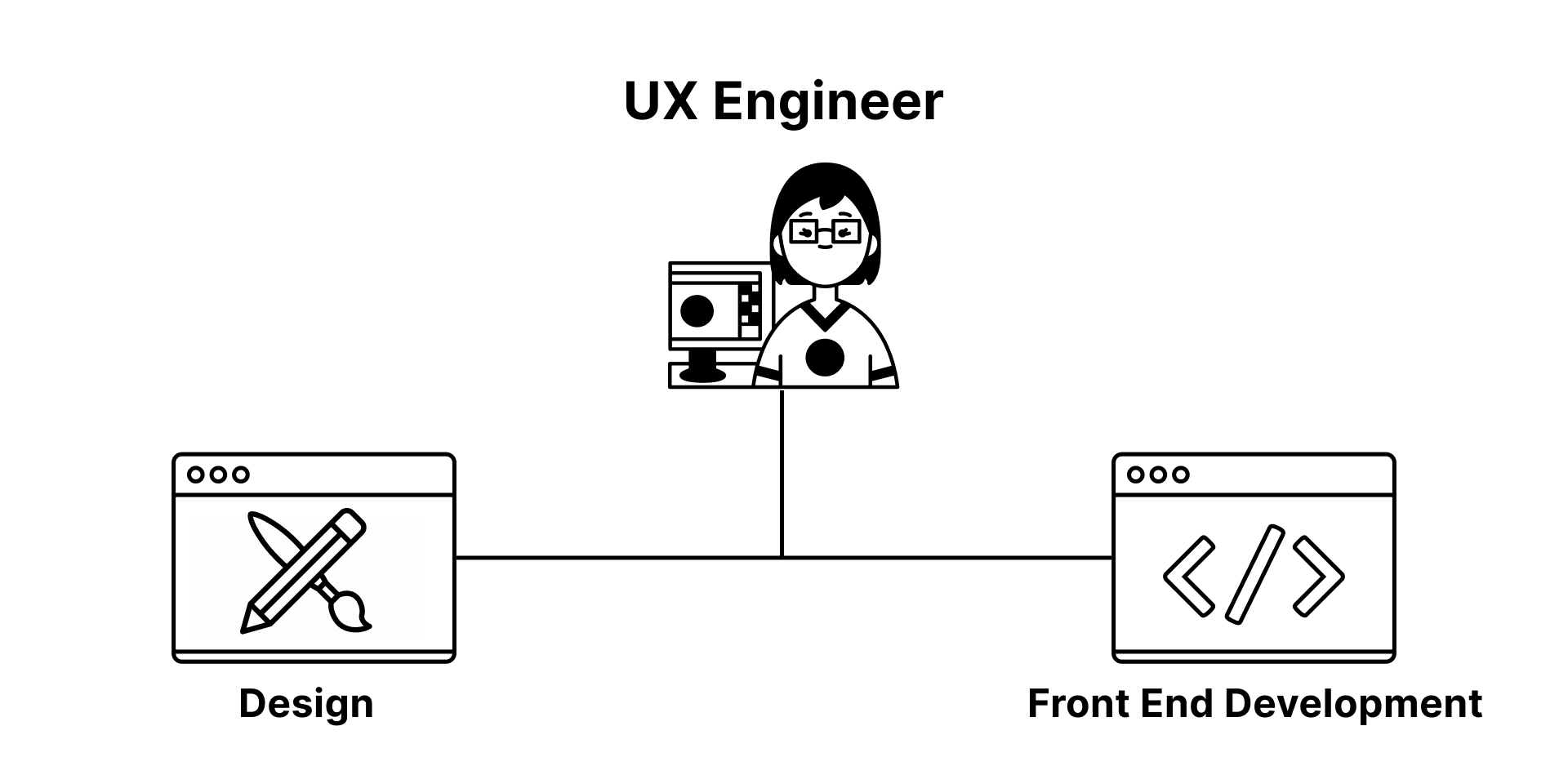I am currently a User Experience or UX Engineer for D2iQ. And lots of people ask me what exactly is a UX Engineer.
This question comes from designers and developers alike. So, I figured it was time to write about it to create awareness and demystify the role.
This article will help you understand what a UX Engineer is, what their duties are, the required skillset, and it may even convince you to be come one yourself.
What Does User Experience Mean?
Before we jump into the role of UX Engineer, let's take a brief moment to define User Experience.
Most people are familiar with UI, which refers to the user interface. The user interface is most commonly the screen in which user is interacting with, for example a website or application.
UX relates to the all encompassing experiences the end user has while using a product or service, UI included.
The significance of UX is undeniable. In The User Experience Team of One, author Leah Buley notes,
“UX is a force for good. In an increasingly technological world, designing products with real people in mind helps us make sure that technology integrates in our lives in a human way. It’s a voice of reason, arguing that products and technology can support and even enrich our fundamental humanity.”
Who are UX Engineers?
A UX Engineer (UXE) is the bridge between design and development.

Engineers
UXE's are engineers first, with a working knowledge of design. Front end development skills are a prerequisite. A UXE cares deeply about the user experience and is heavily involved in impacting it.
"Developers write the code and build the systems that make the experience real. That moment when a flat concept on a page becomes a working, functioning, interactive thing is like making life. It’s incredibly rewarding. It also enables them to see and understand how it will feel and function for the enduser." – The User Experience Team of One
Designers
UXEs can be particularly useful in conceptualization stages of design. They are able to help designers understand what is feasible and how much engineering effort it may take to achieve.
Some UXE's will contribute prototypes, wireframes, and design mockups. The amount of true design work can vary from company to company.
It is common for a UX Engineer to be working within a Design System. For example, my role at D2iQ includes maintaining a design system and component library.
Advocates
A UXE will need to have empathy for both sides and be able to advocate for design or development. They may be required to push back on either side as an advocate. This is the reason they are considered the bridge between design and development.
A UXE may even need to advocate for UX itself within their organization, to create awareness and to build support for their work. This can be achieved through setting up a peer-to-peer learning community, lunch and learn meetings, and other methods to share and educate others.
You may find varying definitions of what a UX Engineer means. The lines are often blurred between UI Engineer, UX Engineer, and Design Technologist. Much of the role can depend on the company and what are the needs they want to fill with that role.
You may thrive as a UXE if you enjoy:
- Front end engineering
- Styling with CSS specifically
- Design thinking
- Occasionally flexing some design skills
- Participating in UX Research
- Working with Design Systems
- Creative leeway
We'll dive deeper on the skills required as a UXE which may clarify what exactly it entails.
Confusion within the Front End
I wanted to make a note on the confusion between UI Engineer, UX Engineer and Front End Engineer. These are often assumed to be the same role. That may or may not be the case, depending on what is in the job description. However, there are some notable differences.
UI Engineer is the most similar to a Front End Engineer. They're not entirely the same historically, but the line between the two has become blurry. They will work on the technical side of building the user interface. Working on the UI can easily start to bleed into UX topics as they are tightly coupled, which may be where the confusion arises.
On the other hand, a UX Engineer is the more design forward of the two. A UXE is a technical role that is intrinsically involved in the user's experience. They would be the one to consider "how is the user interacting with this button?", "how can I make it absolutely clear what this button does", and "how can I provider the user a better experience when using this button?"
On the other hand, a UI Engineer would generally ask themselves how to best match the design to engineer an efficient button.
This is of course glossing over the depths that each role can go into. UI Engineers can become more involved in UX if they take a conscious efforts to impact it.
The job description of UX Engineer might align more with what you would see under Design Technologist or Design System Engineer.
Overall, the term Front End can cover a broad range of individually complex topics and skillsets, which is why we are starting to see the need to define more specific roles within Front End. UX Engineer is among the more recent positions to become defined based on this.
Required Skills for a User Experience Engineer
There are many skills that a UXE may possess that aren't limited to Front End development and design. Again, much of the role can be dictated by the company’s definition of the role and responsibilities.
Below are some of the key skills that would be most commonly applicable and helpful to have.
Technical Skills
Front End Development. This includes knowledge of HTML, CSS and JavaScript. You should also know popular JavaScript libraries such as React. This could additionally include testing, debugging, build tools, and dependency managers.
CSS Specialists. It is important to note that the role requires in-depth knowledge of CSS. This could entail CSS architecture or working with preprocessors like Sass and Less. It's beneficial to have experience with CSS-in-JS libraries such as Styled Components and Emotion.
UI/UX Design. This may be a mix of design related skills from prototyping to UX Principles to wire-framing. UXE’s may produce low-fidelity or high-fidelity design mockups. It is helpful to have experience with design tools such as Figma, Sketch, or InVision. Design systems could also be lumped into this category. It's valuable to understand the benefit of design systems, and knowing how to enforce the design standards in the UI.
Storybook. Storybook is a tool to help engineers build, test, and display UI components. Working with Storybook will require additional niche technical know-how specific to this tool. There is a likelihood that if you are working with a design system and component library, the documentation is utilizing Storybook.
Accessibility. To excel in this role, you need to understand accessibility guidelines. Caring for users means inclusive design. Products should not limit the type of user. Products should account for all users. Having technical skills to test and improve the accessibility of applications will be extremely beneficial.
Responsive Design. Designers may only be able to mock up several screen size views such as mobile, tablet, and desktop. You'll be implementing those designs. There are gaps between each screen size mock which will require technical and decision making skills and for a seamless transition. These are the types of problems you will encounter and they impact the user experience.
Less Technical Skills
Empathy. This is a crucial skill for a UXE. They need to understand users in order to improve their experience. This includes having a passion for understanding how people think. Caring deeply about the impact you can have on user experiences will take you far in this field.
Communication and Collaboration. UXEs are required to do a lot of cross-functional communication. They can speak with users, designers, developers, product owners, and stakeholders. They are held responsible for translations between design and engineering teams. There is a likelihood of contributing to documentation which uses written communication skills. This could include documenting style guides, components, or guides for users.
Creativity. It may seem obvious that this would be a great skill to have based on the design factor of the role. UXE's have the opportunity to find creative solutions especially when design and development need to meet in the middle.
User Experience Principles and Theories. Understanding the psychological aspect of UX will come in handy when making design decisions. Learning psychological heuristics is essential. The Laws of UX site is a great overview of these.
Summary
As design and engineering processes mature, there is a need for roles like UX Engineer, UX Researcher, UI/UX Designer, UI Engineer, and more, each with their own set of advanced skills.
By collaborating, these roles are able to come together to create top-notch experiences for users. The need for many of these roles has been increasing in recent years, especially with the recognization of the importance of design systems within organizations.
UX Engineers fill a void that can be beneficial to the handoff between design and development. We will continue to see an increasing amount of UX Engineering roles surface as the significance of this role becomes further recognized.
I love the blend of skills that I am able to use daily as a UXE. If you are a creative individual who wants to work closer with design teams this may be the perfect role for you too.
If you would like to learn more about working as a UX Engineer, feel free to reach out on Twitter.

